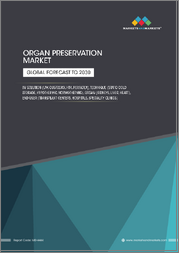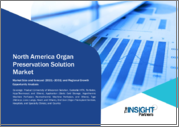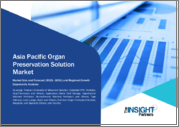
|
시장보고서
상품코드
1642801
장기 보존 시장 : 시장 규모, 점유율, 동향, 예측 - 보존 솔루션별, 장기 제공 유형별, 수법별, 장기 유형별, 최종 사용자별, 지역별(2025-2033년)Organ Preservation Market Size, Share, Trends and Forecast by Preservation Solution, Organ Donation Type, Technique, Organ Type, End-User, and Region, 2025-2033 |
||||||
세계의 장기 보존 시장 규모는 2024년 1억 9,887만 달러가 됐습니다. IMARC Group은 향후 시장이 2033년까지 3억 2,040만 달러에 이를 전망이며, 2025년부터 2033년까지 5.39%의 연평균 복합 성장률(CAGR)을 나타낼 것으로 예측했습니다. 현재 시장을 독점하고 있는 것은 북미이며, 2024년 시장 점유율은 45.9%를 넘었습니다. 북미의 성장 원동력은 첨단 건강 관리 인프라, 장기 이식 증가, 기술 진보, 정부의 지원책입니다.
장기 보존이란 기증자의 체내에서 채취한 건강한 장기를 보존하는 과정을 말합니다. 이 과정에서 기증자의 체내에서 장기를 제거하고 운송을 위해 보관한 후, 큰 손상을 주지 않으면서 수령인의 체내에 이식합니다. 신장, 간, 폐, 심장 및 기타 장기의 온도와 산소 수준을 유지하기 위해 저체온 기계 관류, 정적 저온 보존(SCS), 정상 체온 기계 관류(NMP) 등 다양한 기술이 사용됩니다. 사용되는 보존 기술과 용액은 이식 후 환자의 이환율과 생존율에 직접 영향을 미치는 기증자 장기의 품질에 필수적입니다.
장기 보존 시장 동향 :
만성 질환의 유병률 증가는 세계 노인 인구 증가와 함께 시장 성장을 가속하는 주요 요인 중 하나입니다. 당뇨병, 심혈관 장애(CVDs), 비만 및 기타 심각한 병리로 인해 장기 부전이 자주 발생하기 때문에 장기 온존의 필요성이 높아지고 있습니다. 장기 보존을 위한 NMP와 같은 혁신적이고 고급 기술의 출현은 성장을 가속하는 요인으로 작용합니다. 이러한 기술은 이식 중 재관류 장애의 확률을 감소시키는 데 도움이 되었으며 임상 및 실험적 연구를 위한 저온 보존에서 개선된 결과를 보여줍니다. 또한 장기 제공을 촉진하는 정부 및 비정부 정책과 이니셔티브 증가가 시장 성장에 긍정적 영향을 미칩니다. 이식이나 연구 목적으로 장기 제공을 지원하는 개인 증가도 시장을 더욱 견인하고 있습니다. 연구개발(R&D)의 강화나 장기보존 인프라의 대폭적인 진보 등 기타 요인도 시장 성장에 크게 공헌할 것으로 예측되고 있습니다.
목차
제1장 서문
제2장 조사 범위 및 조사 방법
- 조사의 목적
- 이해관계자
- 데이터 소스
- 1차 정보
- 2차 정보
- 시장 추정
- 상향식 접근
- 하향식 접근
- 조사 방법
제3장 주요 요약
제4장 서문
- 개요
- 주요 업계 동향
제5장 세계의 장기 보존 시장
- 시장 개요
- 시장 실적
- COVID-19의 영향
- 시장 예측
제6장 시장 내역 : 보존 솔루션별
- UW 솔루션
- 시장 동향
- 시장 예측
- Custodiol HTK
- 시장 동향
- 시장 예측
- Perfadex
- 시장 동향
- 시장 예측
- 기타
- 시장 동향
- 시장 예측
제7장 시장 내역 : 장기 제공 유형별
- 생체 장기 제공
- 시장 동향
- 시장 예측
- 시체 장기 제공
- 시장 동향
- 시장 예측
제8장 시장 내역 : 수법별
- 정적 냉장
- 시장 동향
- 시장 예측
- 저체온 머신 관류
- 시장 동향
- 시장 예측
- 상온기계 관류
- 시장 동향
- 시장 예측
- 기타
- 시장 동향
- 시장 예측
제9장 시장 내역 : 장기별
- 신장
- 시장 동향
- 시장 예측
- 간
- 시장 동향
- 시장 예측
- 폐
- 시장 동향
- 시장 예측
- 심장
- 시장 동향
- 시장 예측
- 기타
- 시장 동향
- 시장 예측
제10장 시장 내역 : 최종 사용자별
- 병원 및 진료소
- 시장 동향
- 시장 예측
- 장기 뱅크
- 시장 동향
- 시장 예측
- 기타
- 시장 동향
- 시장 예측
제11장 시장 내역 : 지역별
- 북미
- 미국
- 캐나다
- 아시아태평양
- 중국
- 일본
- 인도
- 한국
- 호주
- 인도네시아
- 기타
- 유럽
- 독일
- 프랑스
- 영국
- 이탈리아
- 스페인
- 러시아
- 기타
- 라틴아메리카
- 브라질
- 멕시코
- 기타
- 중동 및 아프리카
- 시장 동향
- 시장 내역 : 국가별
- 시장 예측
제12장 SWOT 분석
- 개요
- 강점
- 약점
- 기회
- 위협
제13장 밸류체인 분석
제14장 Porter's Five Forces 분석
- 개요
- 구매자의 협상력
- 공급기업의 협상력
- 경쟁도
- 신규 참가업체의 위협
- 대체품의 위협
제15장 가격 지표
제16장 경쟁 구도
- 시장 구조
- 주요 기업
- 주요 기업 프로파일
- 21st Century Medicine Inc.
- Biolife Solutions Inc.
- Bridge to Life Ltd.
- Bristol-Myers
- Dr. Franz Kohler Chemie GmbH
- Essential Pharmaceuticals LLC
- Lifeline Scientific Inc.
- OrganOx Ltd.
- Paragonix Technologies Inc.
- Transmedics, Inc.
- Waters Medical Systems LLC
- Xvivo Perfusion
The global organ preservation market size was valued at USD 198.87 Million in 2024. Looking forward, IMARC Group estimates the market to reach USD 320.40 Million by 2033, exhibiting a CAGR of 5.39% from 2025-2033. North America currently dominates the market, holding a market share of over 45.9% in 2024. The growth of the North American region is driven by advanced healthcare infrastructure, rising organ transplants, technological advancements, and supportive government initiatives.
Organ preservation refers to the process of preserving healthy organs harvested from the body of donors. The process involves the removal of organs from the donor's body, storing it for transportation and then transplanting it into the receiver's body without significant damage. It utilizes various techniques, such as hypothermic machine perfusion, static cold storage (SCS) and normothermic machine perfusion (NMP), to maintain the temperature and oxygen levels of kidneys, liver, lung, heart and other organs. The preservation techniques and solutions used are essential for donor organ quality, which directly influences the morbidity and survival rates of a patient after transplantation.
Organ Preservation Market Trends:
The increasing prevalence of chronic diseases, along with the growing geriatric population across the globe, are among the key factors driving the growth of the market. Owing to the frequent occurrences of organ failures due to diabetes, cardiovascular disorders (CVDs), obesity, and other such severe medical conditions, there is an increasing need for organ preservation procedures. The advent of innovative and advanced techniques, such as NMP, for organ preservation, is acting as a growth-inducing factor. Such techniques aid in decreasing the probability of reperfusion injury during transplantation and exhibits improved results in cold storage for clinical and experimental studies. Moreover, an increasing number of government and non-government policies and initiatives to promote organ donation are impacting the market growth positively. The rising number of individuals volunteering to donate their organs for transplantation and research purposes are also driving the market further. Other factors, including enhanced research and development (R&D) and significant advancements in the organ preservation infrastructure, are also projected to contribute to the market growth significantly.
Organ Preservation Industry Segmentation:
Breakup by Preservation Solution:
UW Solution
Custodiol HTK
Perfadex
Others
Breakup by Organ Donation Type:
Living Organ Donation
Deceased Organ Donation
Breakup by Technique:
Static Cold Storage Technique
Hypothermic Machine Perfusion
Normothermic Machine Perfusion
Others
Breakup by Organ Type:
Kidney
Liver
Lung
Heart
Others
Breakup by End-User:
Hospitals and Clinics
Organ Banks
Others
Breakup by Region:
North America
United States
Canada
Asia Pacific
China
Japan
India
South Korea
Australia
Indonesia
Others
Europe
Germany
France
United Kingdom
Italy
Spain
Russia
Others
Latin America
Brazil
Mexico
Others
Middle East and Africa
Competitive Landscape:
The report has also analysed the competitive landscape of the market with some of the key players being 21st Century Medicine, Biolife Solutions, Bridge to Life Ltd., Bristol-Myers Squibb, Dr. Franz Kohler Chemie GmbH, Essential Pharmaceuticals., Lifeline Scientific, OrganOx, Paragonix Technologies, TransMedics, Waters Medical Systems, Xvivo Perfusion, etc.
Key Questions Answered in This Report
- 1. What is organ preservation?
- 2. How big is the global organ preservation market?
- 3. What is the expected growth rate of the global organ preservation market during 2025-2033?
- 4. What are the key factors driving the global organ preservation market?
- 5. What is the leading segment of the global organ preservation market based on preservation solution?
- 6. What is the leading segment of the global organ preservation market based on organ donation type?
- 7. What is the leading segment of the global organ preservation market based on technique?
- 8. What is the leading segment of the global organ preservation market based on organ type?
- 9. What is the leading segment of the global organ preservation market based on end-user?
- 10. What are the key regions in the global organ preservation market?
- 11. Who are the key players/companies in the global organ preservation market?
Table of Contents
1 Preface
2 Scope and Methodology
- 2.1 Objectives of the Study
- 2.2 Stakeholders
- 2.3 Data Sources
- 2.3.1 Primary Sources
- 2.3.2 Secondary Sources
- 2.4 Market Estimation
- 2.4.1 Bottom-Up Approach
- 2.4.2 Top-Down Approach
- 2.5 Forecasting Methodology
3 Executive Summary
4 Introduction
- 4.1 Overview
- 4.2 Key Industry Trends
5 Global Organ Preservation Market
- 5.1 Market Overview
- 5.2 Market Performance
- 5.3 Impact of COVID-19
- 5.4 Market Forecast
6 Market Breakup by Preservation Solution
- 6.1 UW Solution
- 6.1.1 Market Trends
- 6.1.2 Market Forecast
- 6.2 Custodiol HTK
- 6.2.1 Market Trends
- 6.2.2 Market Forecast
- 6.3 Perfadex
- 6.3.1 Market Trends
- 6.3.2 Market Forecast
- 6.4 Others
- 6.4.1 Market Trends
- 6.4.2 Market Forecast
7 Market Breakup by Organ Donation Type
- 7.1 Living Organ Donation
- 7.1.1 Market Trends
- 7.1.2 Market Forecast
- 7.2 Deceased Organ Donation
- 7.2.1 Market Trends
- 7.2.2 Market Forecast
8 Market Breakup by Technique
- 8.1 Static Cold Storage Technique
- 8.1.1 Market Trends
- 8.1.2 Market Forecast
- 8.2 Hypothermic Machine Perfusion
- 8.2.1 Market Trends
- 8.2.2 Market Forecast
- 8.3 Normothermic Machine Perfusion
- 8.3.1 Market Trends
- 8.3.2 Market Forecast
- 8.4 Others
- 8.4.1 Market Trends
- 8.4.2 Market Forecast
9 Market Breakup by Organ Type
- 9.1 Kidney
- 9.1.1 Market Trends
- 9.1.2 Market Forecast
- 9.2 Liver
- 9.2.1 Market Trends
- 9.2.2 Market Forecast
- 9.3 Lung
- 9.3.1 Market Trends
- 9.3.2 Market Forecast
- 9.4 Heart
- 9.4.1 Market Trends
- 9.4.2 Market Forecast
- 9.5 Others
- 9.5.1 Market Trends
- 9.5.2 Market Forecast
10 Market Breakup by End-User
- 10.1 Hospitals and Clinics
- 10.1.1 Market Trends
- 10.1.2 Market Forecast
- 10.2 Organ Banks
- 10.2.1 Market Trends
- 10.2.2 Market Forecast
- 10.3 Others
- 10.3.1 Market Trends
- 10.3.2 Market Forecast
11 Market Breakup by Region
- 11.1 North America
- 11.1.1 United States
- 11.1.1.1 Market Trends
- 11.1.1.2 Market Forecast
- 11.1.2 Canada
- 11.1.2.1 Market Trends
- 11.1.2.2 Market Forecast
- 11.1.1 United States
- 11.2 Asia Pacific
- 11.2.1 China
- 11.2.1.1 Market Trends
- 11.2.1.2 Market Forecast
- 11.2.2 Japan
- 11.2.2.1 Market Trends
- 11.2.2.2 Market Forecast
- 11.2.3 India
- 11.2.3.1 Market Trends
- 11.2.3.2 Market Forecast
- 11.2.4 South Korea
- 11.2.4.1 Market Trends
- 11.2.4.2 Market Forecast
- 11.2.5 Australia
- 11.2.5.1 Market Trends
- 11.2.5.2 Market Forecast
- 11.2.6 Indonesia
- 11.2.6.1 Market Trends
- 11.2.6.2 Market Forecast
- 11.2.7 Others
- 11.2.7.1 Market Trends
- 11.2.7.2 Market Forecast
- 11.2.1 China
- 11.3 Europe
- 11.3.1 Germany
- 11.3.1.1 Market Trends
- 11.3.1.2 Market Forecast
- 11.3.2 France
- 11.3.2.1 Market Trends
- 11.3.2.2 Market Forecast
- 11.3.3 United Kingdom
- 11.3.3.1 Market Trends
- 11.3.3.2 Market Forecast
- 11.3.4 Italy
- 11.3.4.1 Market Trends
- 11.3.4.2 Market Forecast
- 11.3.5 Spain
- 11.3.5.1 Market Trends
- 11.3.5.2 Market Forecast
- 11.3.6 Russia
- 11.3.6.1 Market Trends
- 11.3.6.2 Market Forecast
- 11.3.7 Others
- 11.3.7.1 Market Trends
- 11.3.7.2 Market Forecast
- 11.3.1 Germany
- 11.4 Latin America
- 11.4.1 Brazil
- 11.4.1.1 Market Trends
- 11.4.1.2 Market Forecast
- 11.4.2 Mexico
- 11.4.2.1 Market Trends
- 11.4.2.2 Market Forecast
- 11.4.3 Others
- 11.4.3.1 Market Trends
- 11.4.3.2 Market Forecast
- 11.4.1 Brazil
- 11.5 Middle East and Africa
- 11.5.1 Market Trends
- 11.5.2 Market Breakup by Country
- 11.5.3 Market Forecast
12 SWOT Analysis
- 12.1 Overview
- 12.2 Strengths
- 12.3 Weaknesses
- 12.4 Opportunities
- 12.5 Threats
13 Value Chain Analysis
14 Porters Five Forces Analysis
- 14.1 Overview
- 14.2 Bargaining Power of Buyers
- 14.3 Bargaining Power of Suppliers
- 14.4 Degree of Competition
- 14.5 Threat of New Entrants
- 14.6 Threat of Substitutes
15 Price Indicators
16 Competitive Landscape
- 16.1 Market Structure
- 16.2 Key Players
- 16.3 Profiles of Key Players
- 16.3.1 21st Century Medicine Inc.
- 16.3.1.1 Company Overview
- 16.3.1.2 Product Portfolio
- 16.3.2 Biolife Solutions Inc.
- 16.3.2.1 Company Overview
- 16.3.2.2 Product Portfolio
- 16.3.2.3 Financials
- 16.3.3 Bridge to Life Ltd.
- 16.3.3.1 Company Overview
- 16.3.3.2 Product Portfolio
- 16.3.4 Bristol-Myers
- 16.3.4.1 Company Overview
- 16.3.4.2 Product Portfolio
- 16.3.4.3 Financials
- 16.3.4.4 SWOT Analysis
- 16.3.5 Dr. Franz Kohler Chemie GmbH
- 16.3.5.1 Company Overview
- 16.3.5.2 Product Portfolio
- 16.3.5.3 Financials
- 16.3.6 Essential Pharmaceuticals LLC
- 16.3.6.1 Company Overview
- 16.3.6.2 Product Portfolio
- 16.3.7 Lifeline Scientific Inc.
- 16.3.7.1 Company Overview
- 16.3.7.2 Product Portfolio
- 16.3.8 OrganOx Ltd.
- 16.3.8.1 Company Overview
- 16.3.8.2 Product Portfolio
- 16.3.8.3 Financials
- 16.3.9 Paragonix Technologies Inc.
- 16.3.9.1 Company Overview
- 16.3.9.2 Product Portfolio
- 16.3.10 Transmedics, Inc.
- 16.3.10.1 Company Overview
- 16.3.10.2 Product Portfolio
- 16.3.11 Waters Medical Systems LLC
- 16.3.11.1 Company Overview
- 16.3.11.2 Product Portfolio
- 16.3.12 Xvivo Perfusion
- 16.3.12.1 Company Overview
- 16.3.12.2 Product Portfolio
- 16.3.12.3 Financials
- 16.3.1 21st Century Medicine Inc.



















